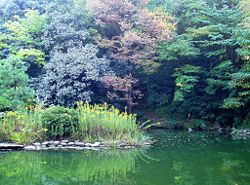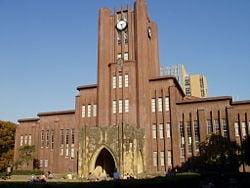University of Tokyo
| Established | 1877 |
|---|---|
| Type | Public |
| Location | Bunkyo, Tokyo Japan |
| Website | www.u-tokyo.ac.jp |
The University of Tokyo (東京大学; Tōkyō Daigaku, abbreviated as 東大 Tōdai) is one of the leading research universities in Japan. According to the Institute of Higher Education, the university is the best in the Asian Pacific Region. The University has five campuses in Hongo, Komaba, Kashiwa, Shirokane and Nakano and 10 departments with a total of around 30,000 students, some 2,100 of them foreign (a large fraction by Japanese standards). While nearly all academic disciplines are taught at the University, it is perhaps best known for its faculties of law and literature. This university has produced many Japanese politicians, though the power of the school has been gradually decreasing. For example; the ratio of its alumni in prime ministers is 2/3, 1/2, 1/4, 1/5 and 1/6 in the 1950s, 60s, 70s, 80s and 90s respectively. The University of Tokyo is widely thought of as being one of the most prestigious schools over many areas while its rival schools are the other six of the Seven Universities, which were Imperial Universities before World War II, especially Kyoto University. In science, Kyoto University has produced more top scientists and Nobel prize winners. One of the presidents of Tokyo Imperial University was Kikuchi Dairoku.
It is one of the Tokyo 6 Universities in baseball.
History
The university was founded by the Meiji government in 1877 under its current name by amalgamating older government schools for medicine and Western learning. It was renamed the Imperial University (帝國大學 Teikoku Daigaku) in 1886 and then "Tokyo Imperial University" (東京帝國大學 Tōkyō Teikoku Daigaku) in 1887. In 1947, after Japan's defeat in World War II, the university again assumed its original name. With the start of the new university system in 1949, Tōdai swallowed up the old First Higher School (today's Komaba campus) and the old Tokyo Higher School, which henceforth assumed the duty of teaching first and second-year undergraduates, while the faculties on Hongo main campus took care of third and fourth-year students.
The University of Tokyo has since 2004 been incorporated as a national university corporation under a new law which applies to all national universities. Despite the incorporation, which has led to increased financial independence and autonomy, The University of Tokyo is still partly controlled by the Ministry of Education, Culture, Sports, Science and Technology (MEXT, Monbukagakusho, or Monbusho).
Facilities
The main Hongo campus occupies the former estate of the Maeda family, who were the feudal lords of the Kaga Province during the Edo period. The university's best known landmark, the Akamon (Red Gate), is a relic of this era. The symbol of the university is the ginkgo leaf, which comes from the trees that are abundant throughout the area.
University of Tokyo Library
The University of Tokyo Library consists of three main branches: the General, Komaba, and Kashiwa Libraries. The General Library plays the central role in providing service to all the researchers and students of the university as well as in giving administrative support to other branch libraries. The library houses approximately 1,090,000 books, and its valuable collections attract many researchers in and outside of the university. The library was originally opened in 1878. The smaller Komaba Library mainly supports the studies of the first two years of undergraduate education; and the Kashiwa Library, opened in 2004, is devoted to the natural sciences, functioning as the back number center for those materials. The University of Tokyo also houses more than 60 faculty/institution libraries in various academic fields. The library system at the University of Tokyo has the largest collection in Japan, holding a total of over 8,000,000 books.
The University of Tokyo Library houses many major collections. These include the Akiba Collection, nearly 17,000 volumes which list the title and the casts of the Kabuki presented on the stage during the Empo-Meiji eras, and the Katei Collection of Japanese fictions in the Edo period. The library also houses the Ogai Collection, with nearly 19,000 volumes of biographical and historical books, old maps from the Edo period, and European literature, and the Seishu Collection of 25,000 volumes of Chinese classics and Japanese literature, as well as literature on politics and economic policy during the World War II.
All persons affiliated with the University of Tokyo are eligible for use of the library. This includes faculty members, graduate students, undergraduate students, auditors, personnel, and others who have been approved by the director. Persons from outside University of Tokyo, such as former faculty members, personnel, alumni, and others can also use the library for reference only. Inter-library loan & delivery service between libraries in the campuses is available for researchers as well as teachers and graduates. The University of Tokyo Library has extensive online resources as well. For example, the Online Public Access Catalog can be used by the general public to search the journals and books held in the University libraries. In addition, the online Book Contents Database allows for access to the actual content of the library's books. Approximately 229,820 volumes of books andmaterials held by the University of Tokyo can be searched through this system. The library's online resources also include a doctorial dissertation database, a database of newspapers and a list of microforms held at the library, a catalog of classical chinese books and a catalog of historical documents.
Sanshiro Pond
Sanshiro Pond, in the heart of the university's Hongo campus, dates back to 1615. After the fall of the Osaka Castle, the Shogun gave this pond and its surrounding garden to Maeda Toshitsune. As Maeda Tsunanori further developed the garden, it became known as one of the most beautiful gardens in the region. It has the traditional eight landscapes and eight borders, but is also known for the originality of its artificial pond, hills, and pavilions. It was at that time known as Ikutoku-en (Garden of Teaching Virtue). The pond's contours are in the shape of the character kokoro or shin (heart), and thus its official name is Ikutoku-en Shinjiike. However it has been commonly called Sanshiro Pond since the publication of Natsume Soseki's novel Sanshiro.
Departments and Graduate Schools
Departments
- Law
- Medicine
- Engineering
- Letters
- Science
- Agriculture
- Economics
- Arts and Sciences
- Education
- Pharmaceutical Sciences
Graduate Schools
- Law and Politics
- Medicine
- Engineering
- Humanities and Sociology
- Science
- Agricultural and Life Sciences
- Economics
- Arts and Sciences
- Education
- Pharmaceutical Sciences
- Mathematical Sciences
- Frontier Sciences
- Information Science and Technology
- Interdisciplinary Information Studies
- Public Policy
Research Institutes
- Institute of Medical Science
- Earthquake Research Institute
- Institute of Oriental Culture
- Institute of Social Science
- Institute of Socio-Information and Communication Studies
- Institute of Industrial Science
- Historiographical Institute
- Institute of Molecular and Cellular Biosciences
- Institure for Cosmic Ray Research
- Institute for Solid State Physics
- Ocean Research Institute
Notable alumni
Prime Ministers
- Shigeru Yoshida (1946-1947,1948-1954)
- Nobusuke Kishi (1957-1960)
- Eisaku Sato (1964-1972)
- Takeo Fukuda (1976-1978)
- Yasuhiro Nakasone (1982-1987)
- Kiichi Miyazawa (1991-1993)
Mathematicians
- Tadatoshi Akiba
- Kiyoshi Itō
- Kenkichi Iwasawa
- Yasumasa Kanada
- Kunihiko Kodaira
- Mikio Sato
- Goro Shimura
- Yutaka Taniyama
- Teiji Takagi
Architects
- Kenzo Tange
- Fumihiko Maki
- Arata Isozaki
- Toyo Ito
Authors
- Kobo Abe
- Akutagawa Ryunosuke
- Yasunari Kawabata, Nobel laureate
- Yukio Mishima, Author
- Wafu Nishijima, Zen Buddhist priest
- Mori Ogai
- Natsume Soseki
- Kenzaburo Oe, Nobel laureate
- Osamu Dazai (dropout)
In entertainment
- Isao Takahata, Anime director
- Mayuko Takata, Actress
- Rei Kikukawa, Actress
- Towa Oshima, Manga-ka
- Yoji Yamada, Movie director
- Koichi Sugiyama, Music composer
Others
- Ah Syong, Founder of Japanese Electric Pole
- Hisashi Owada, International Court of Justice Judge
- Toshihiko Fukui, Governor of the Bank of Japan
- Tadatoshi Akiba, Mayor of Hiroshima
- Leo Esaki, Physicist, Nobel laureate
- Masatoshi Koshiba, Physicist, Nobel laureate
- Hiroo Mori, Real Estate Developer
- Kitaro Nishida, Philosopher
- Ong Iok-tek, Linguist
- Princess Masako, Crown Princess
- Kitsune Ouzora, Founder of OGc and GGB
- Eiji Toyoda, Industrialist
- Daisetz Teitaro Suzuki, Buddhist scholar
- Manshi Kiyozawa, Buddhist thinker
- Toshihiko Atsuyama, professor of Japanese studies at Harvard University
- Watsuji Tetsuro, Philosopher
- Kazuhide "Mirrorman" Uekusa, Economist, former professor at Waseda University graduate school and sex offender
- Takashi Yuasa Lawyer, Economist
- Takafumi Horie, ex-CEO of Livedoor (dropout)
External links
- Book Content Database
- General Library Page
- Komaba Library Page
- Kashiwa Library Page
- Online Public Access Catalog (OPAC, English)
- Online Public Access Catalog (OPAC, Japanese)
- The University of Tokyo Library website (Japanese)
- The University of Tokyo Library website (English)
- Top 100 Asia Pacific Universities
- University of Tokyo
Credits
New World Encyclopedia writers and editors rewrote and completed the Wikipedia article in accordance with New World Encyclopedia standards. This article abides by terms of the Creative Commons CC-by-sa 3.0 License (CC-by-sa), which may be used and disseminated with proper attribution. Credit is due under the terms of this license that can reference both the New World Encyclopedia contributors and the selfless volunteer contributors of the Wikimedia Foundation. To cite this article click here for a list of acceptable citing formats.The history of earlier contributions by wikipedians is accessible to researchers here:
The history of this article since it was imported to New World Encyclopedia:
Note: Some restrictions may apply to use of individual images which are separately licensed.

